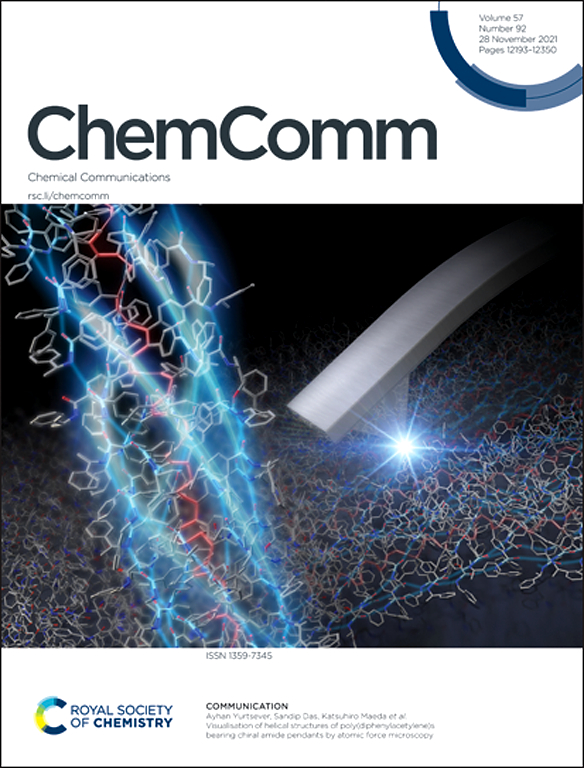Visible-light-assisted synthesis regulates the structure–activity relationship of nanocatalysts for practical direct liquid fuel cells
IF 4.3
2区 化学
Q2 CHEMISTRY, MULTIDISCIPLINARY
引用次数: 0
Abstract
Direct liquid fuel cells (DLFCs) are among the promising energy conversion devices in terms of high energy conversion, low acoustic pollution, wide fuel range, and convenient transportation and storage. Multimetallic nanocatalysts demonstrate promising electrocatalysts for practical DLFCs owing to their bifunctional mechanisms, electronic/strain effects, and synergistic effects, which results in optimal binding affinity for adsorbates, promotes charge transfer, reduces the binding of intermediates, and outperforms CO resistance. The visible-light-assisted method, which is particularly facile and low cost and has strong versatility, and highly adaptable solution for crafting multimetallic nanostructure with adjustable composition and morphology. Considering the cost-effectiveness of this method, this review overviews the latest advancements in the application of DLFCs for the synthesis of multimetallic nanostructures. This review briefly summarizes the operation of DLFCs and the oxidation mechanism of various small-molecule organic fuels, which fills the gap in the research of liquid fuel mechanism. Subsequently, after giving an overview of the equipment and technical principles by visible-light-assisted synthesis, the multimetallic nanostructures prepared by visible-light-assisted fabrication were introduced, including single-atom, nanorods, heterostructures, nanoprisms, and nanoparticles. The applications of light-assisted synthesis of nanostructures in practical DLFCs were highlighted, which focuses on and presents, for the first time, a summary of the development and application of this method in the field of practical DLFC, extending photochemistry into the field of electrochemistry. In the end, the obstacles and development prospects of multi-metallic nanostructured catalysts for the synthesis of visible light are discussed, which provides a broader scientific perspective for researchers.可见光辅助合成调节了实际直接液体燃料电池纳米催化剂的构效关系
直接液体燃料电池(dlfc)具有能量转化率高、声污染小、燃料范围广、运输和储存方便等优点,是一种很有前途的能量转换装置。多金属纳米催化剂由于其双功能机制、电子/应变效应和协同效应,对吸附物具有最佳的结合亲和力,促进电荷转移,减少中间体的结合,并具有更好的CO抗性,因此在实际dlfc中具有很好的电催化剂前景。该方法具有简便、成本低、通用性强的特点,是制备具有可调节成分和形貌的多金属纳米结构的适应性强的解决方案。考虑到该方法的成本效益,本文综述了dlfc在多金属纳米结构合成中的最新应用进展。本文对dlfc的工作原理和各种小分子有机燃料的氧化机理进行了简要综述,填补了液体燃料机理研究的空白。随后,在概述了可见光辅助合成的设备和技术原理后,介绍了可见光辅助合成制备的多金属纳米结构,包括单原子、纳米棒、异质结构、纳米棱镜和纳米颗粒。重点介绍了光辅助合成纳米结构在实际DLFC中的应用,并首次综述了该方法在实际DLFC中的发展和应用,将光化学扩展到电化学领域。最后讨论了多金属纳米结构催化剂用于可见光合成的障碍和发展前景,为研究人员提供了更广阔的科学前景。
本文章由计算机程序翻译,如有差异,请以英文原文为准。
求助全文
约1分钟内获得全文
求助全文
来源期刊

Chemical Communications
化学-化学综合
CiteScore
8.60
自引率
4.10%
发文量
2705
审稿时长
1.4 months
期刊介绍:
ChemComm (Chemical Communications) is renowned as the fastest publisher of articles providing information on new avenues of research, drawn from all the world''s major areas of chemical research.
 求助内容:
求助内容: 应助结果提醒方式:
应助结果提醒方式:


